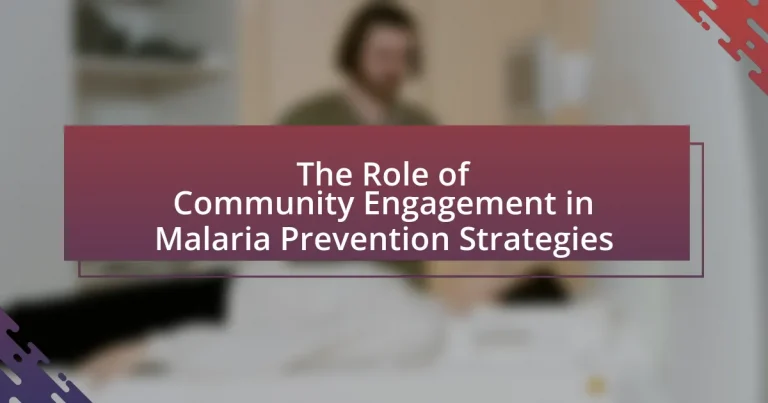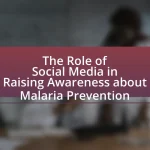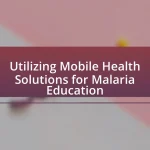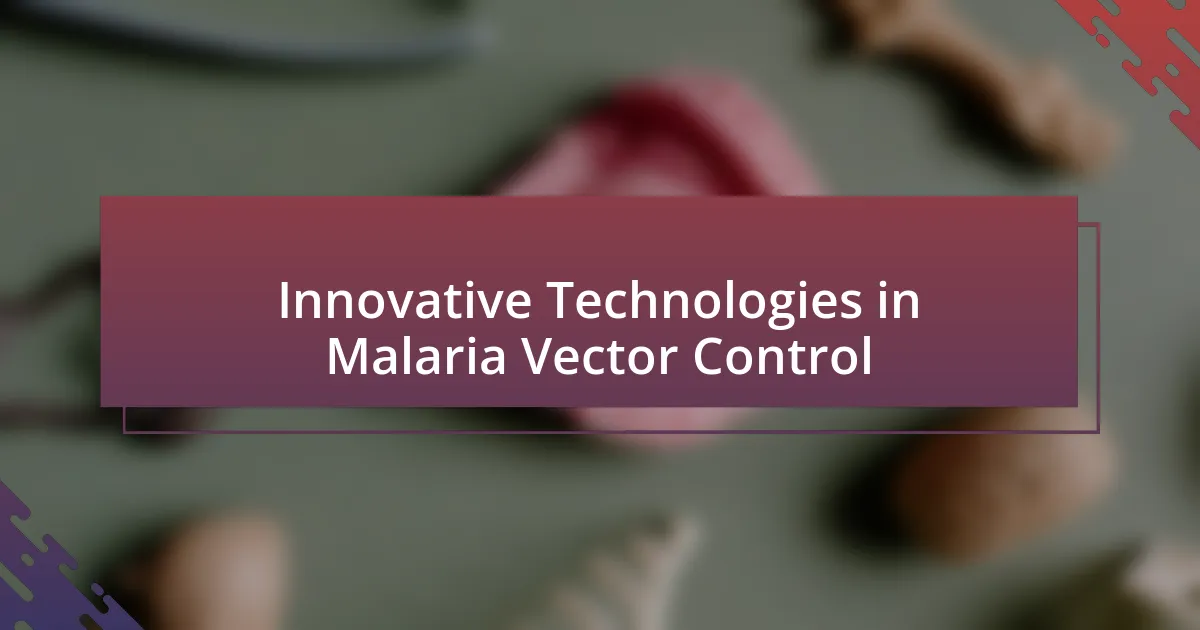The article focuses on the critical role of community engagement in malaria prevention strategies. It highlights how local ownership and participation can significantly enhance the adoption of preventive measures, such as the use of insecticide-treated bed nets and indoor residual spraying, leading to improved health outcomes. Key components of effective community engagement include education, collaboration, and sustainability, while local beliefs and socio-economic factors can influence participation levels. The article also discusses challenges such as misinformation and cultural resistance, and outlines practical steps communities can take to enhance their involvement in malaria prevention efforts.
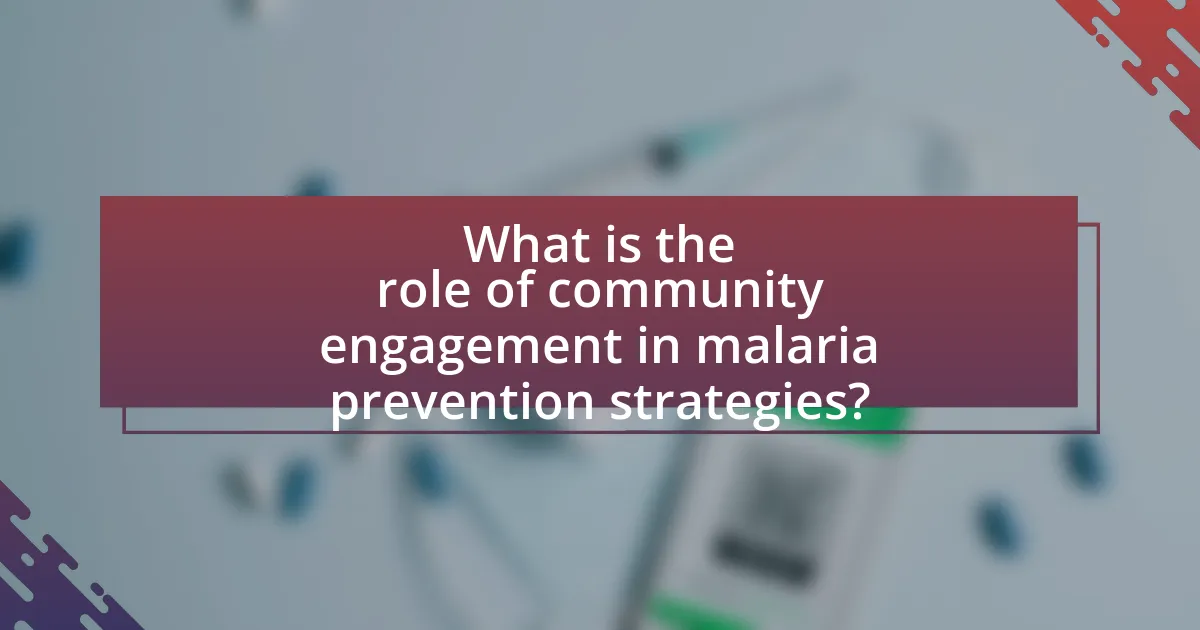
What is the role of community engagement in malaria prevention strategies?
Community engagement plays a critical role in malaria prevention strategies by fostering local ownership and participation in health initiatives. Engaged communities are more likely to adopt preventive measures, such as using insecticide-treated bed nets and participating in indoor residual spraying programs. Research indicates that community involvement can lead to a 50% increase in the use of malaria prevention tools, as seen in studies conducted in sub-Saharan Africa. Furthermore, community engagement enhances awareness and education about malaria transmission and prevention, which is essential for reducing infection rates.
How does community engagement influence malaria prevention efforts?
Community engagement significantly enhances malaria prevention efforts by fostering local ownership and participation in health initiatives. When communities are actively involved, they are more likely to adopt preventive measures such as using insecticide-treated bed nets and participating in indoor residual spraying programs. Research indicates that community-led interventions can increase bed net usage by up to 50%, as seen in studies conducted in sub-Saharan Africa. Furthermore, engaged communities can effectively disseminate information about malaria transmission and prevention, leading to improved health outcomes and reduced incidence rates.
What are the key components of effective community engagement in malaria prevention?
The key components of effective community engagement in malaria prevention include education, participation, collaboration, and sustainability. Education empowers community members with knowledge about malaria transmission, prevention methods, and treatment options, which is crucial for informed decision-making. Participation involves actively involving community members in planning and implementing malaria prevention strategies, ensuring that their voices and needs are considered. Collaboration with local health authorities, NGOs, and community leaders fosters a supportive network that enhances resource sharing and program effectiveness. Sustainability focuses on creating long-term strategies that maintain community involvement and resources, ensuring ongoing malaria prevention efforts. These components are supported by studies showing that community-driven initiatives significantly reduce malaria incidence, as evidenced by successful programs in various regions, such as the community-based interventions in sub-Saharan Africa that led to a 50% reduction in malaria cases.
How do local beliefs and practices shape community engagement in malaria prevention?
Local beliefs and practices significantly influence community engagement in malaria prevention by shaping perceptions of the disease and the effectiveness of interventions. For instance, communities that hold traditional beliefs about malaria may prioritize local remedies over scientifically proven methods, which can hinder the adoption of preventive measures such as insecticide-treated nets or indoor residual spraying. Research conducted in sub-Saharan Africa indicates that when health interventions align with local customs and involve community leaders, acceptance and participation rates increase, leading to more effective malaria control efforts. This demonstrates that understanding and integrating local beliefs into malaria prevention strategies is crucial for enhancing community involvement and ultimately reducing malaria transmission.
Why is community involvement crucial in combating malaria?
Community involvement is crucial in combating malaria because it enhances awareness, promotes preventive measures, and fosters local ownership of health initiatives. Engaging communities leads to better education about malaria transmission and prevention, resulting in increased use of bed nets and participation in spraying campaigns. For instance, studies have shown that community-led interventions can reduce malaria incidence by up to 50% in high-burden areas. Furthermore, local involvement ensures that strategies are culturally relevant and tailored to specific community needs, which significantly improves the effectiveness of malaria control efforts.
What impact does community participation have on malaria awareness and education?
Community participation significantly enhances malaria awareness and education by fostering local ownership and engagement in health initiatives. When communities actively participate, they are more likely to understand the transmission, prevention, and treatment of malaria, leading to increased knowledge and behavioral changes. For instance, a study published in the American Journal of Tropical Medicine and Hygiene found that community-led education programs resulted in a 40% increase in knowledge about malaria prevention methods among participants. This active involvement not only improves awareness but also encourages the adoption of preventive measures, such as the use of insecticide-treated bed nets and seeking timely medical care, ultimately contributing to reduced malaria incidence in the community.
How does community engagement enhance the effectiveness of malaria control measures?
Community engagement enhances the effectiveness of malaria control measures by fostering local ownership and participation in prevention efforts. When communities are actively involved, they are more likely to adopt and sustain practices such as the use of insecticide-treated nets and indoor residual spraying. Research indicates that community-led initiatives can increase the coverage of these interventions; for instance, a study published in the American Journal of Tropical Medicine and Hygiene found that community mobilization significantly improved the uptake of malaria prevention strategies in rural areas. This involvement not only raises awareness but also builds trust in health interventions, leading to better health outcomes and reduced malaria transmission rates.
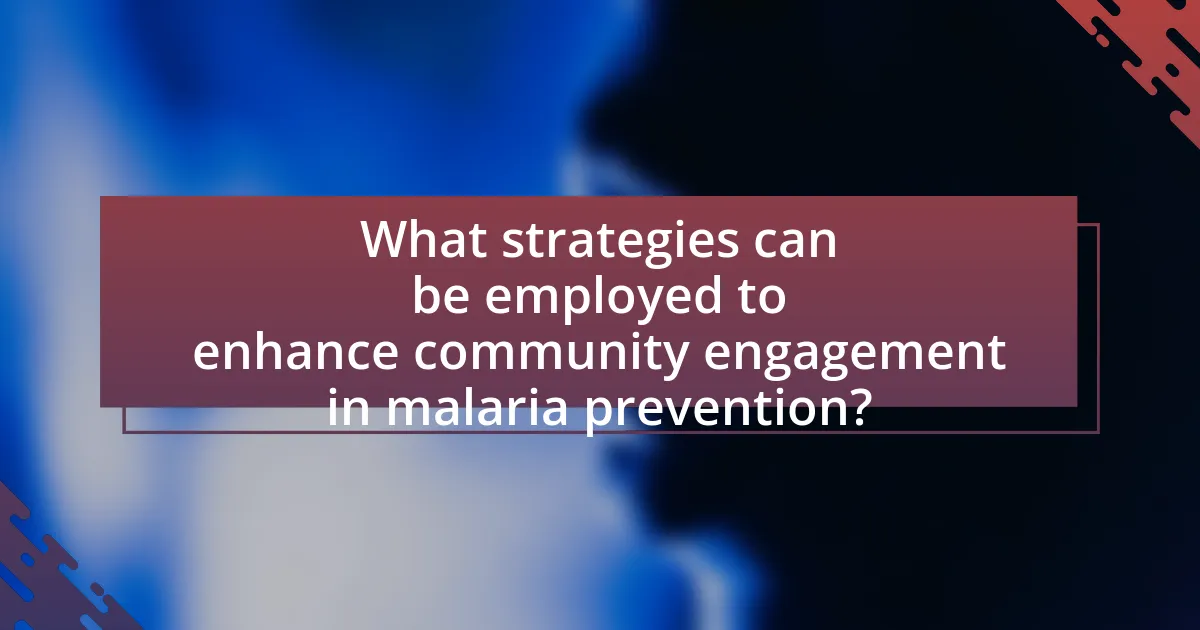
What strategies can be employed to enhance community engagement in malaria prevention?
To enhance community engagement in malaria prevention, strategies such as participatory education, local leadership involvement, and the use of technology can be employed. Participatory education involves training community members to disseminate information about malaria prevention, which has been shown to increase awareness and behavioral change. Local leadership involvement ensures that initiatives are culturally relevant and supported by influential figures, thereby increasing community buy-in. Additionally, utilizing technology, such as mobile health applications, can facilitate communication and provide real-time data on malaria cases, enabling communities to respond effectively. These strategies have been validated by studies indicating that community-driven approaches significantly improve malaria prevention outcomes.
How can local leaders be mobilized for malaria prevention initiatives?
Local leaders can be mobilized for malaria prevention initiatives by engaging them in community education and awareness programs. These programs should highlight the impact of malaria on public health and the economy, demonstrating the importance of their leadership in mobilizing resources and community action. Evidence shows that when local leaders actively participate in health initiatives, such as the “Malaria Control Program” in Nigeria, there is a significant increase in community involvement and adherence to preventive measures, leading to reduced malaria incidence.
What role do community health workers play in fostering engagement?
Community health workers play a crucial role in fostering engagement by acting as liaisons between healthcare systems and the communities they serve. They facilitate communication, build trust, and promote health education, which enhances community participation in malaria prevention strategies. For instance, studies have shown that community health workers significantly increase awareness and understanding of malaria prevention methods, leading to higher rates of community involvement in health initiatives. Their presence in local settings allows for tailored interventions that resonate with community needs, ultimately improving health outcomes and engagement levels.
How can partnerships with local organizations strengthen community involvement?
Partnerships with local organizations can strengthen community involvement by leveraging local knowledge and resources to enhance engagement in malaria prevention strategies. Local organizations often have established trust within the community, which facilitates communication and mobilization efforts. For instance, a study published in the American Journal of Tropical Medicine and Hygiene found that community-based interventions led by local organizations resulted in a 30% increase in participation rates for malaria prevention activities. This demonstrates that when local entities collaborate with health initiatives, they can effectively increase community awareness and participation, ultimately leading to improved health outcomes.
What methods can be used to assess community engagement in malaria prevention?
Methods to assess community engagement in malaria prevention include surveys, focus group discussions, participatory observation, and community mapping. Surveys can quantify community knowledge, attitudes, and practices regarding malaria prevention, providing statistical insights into engagement levels. Focus group discussions facilitate in-depth understanding of community perceptions and barriers to engagement. Participatory observation allows researchers to witness community interactions and behaviors related to malaria prevention efforts in real-time. Community mapping visually represents areas of high engagement and identifies gaps in malaria prevention activities. These methods collectively offer a comprehensive assessment of community involvement in malaria prevention initiatives.
What indicators can measure the effectiveness of community engagement strategies?
Indicators that can measure the effectiveness of community engagement strategies include participation rates, feedback quality, and behavioral changes within the community. Participation rates reflect the number of individuals actively involved in engagement activities, which can be quantified through attendance records or surveys. Feedback quality assesses the depth and relevance of community input, often measured through structured interviews or focus groups that evaluate community perceptions and suggestions. Behavioral changes indicate the impact of engagement on community practices, such as increased use of malaria prevention methods, which can be tracked through health surveys or observational studies. These indicators provide concrete metrics to evaluate the success of community engagement in malaria prevention strategies.
How can feedback from the community improve malaria prevention efforts?
Feedback from the community can significantly improve malaria prevention efforts by ensuring that strategies are culturally relevant and effectively address local needs. Engaging community members allows health organizations to gather insights on local malaria transmission patterns, treatment accessibility, and community attitudes towards prevention measures. For instance, a study published in the American Journal of Tropical Medicine and Hygiene found that community-driven initiatives led to a 30% increase in the use of insecticide-treated nets in areas where local feedback was incorporated into health campaigns. This demonstrates that when communities are actively involved in the planning and implementation of malaria prevention strategies, the initiatives are more likely to succeed and be sustained over time.
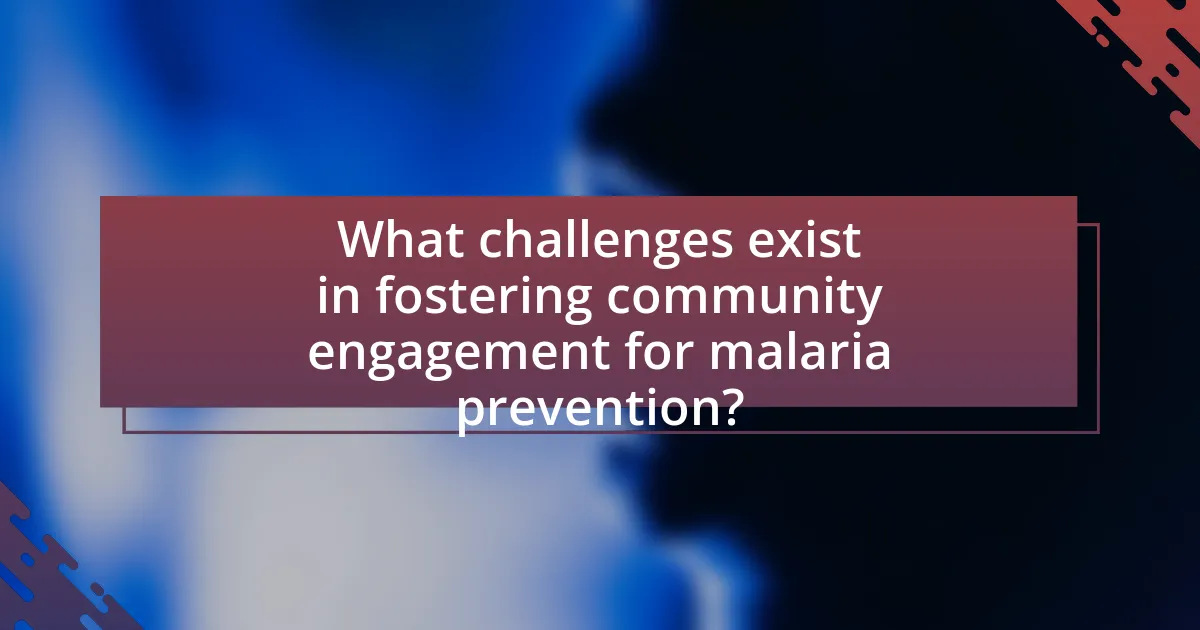
What challenges exist in fostering community engagement for malaria prevention?
Fostering community engagement for malaria prevention faces several challenges, including cultural beliefs, misinformation, and lack of resources. Cultural beliefs can lead to resistance against modern prevention methods, as communities may prioritize traditional practices over scientifically proven interventions. Misinformation about malaria transmission and prevention can further hinder engagement, as individuals may not understand the importance of measures like insecticide-treated nets or indoor residual spraying. Additionally, a lack of resources, such as funding and trained personnel, limits the ability of health organizations to effectively mobilize communities and sustain engagement efforts. These challenges collectively impede the effectiveness of malaria prevention strategies, as evidenced by studies showing that communities with strong engagement have significantly lower malaria incidence rates.
What barriers hinder effective community participation in malaria prevention?
Barriers that hinder effective community participation in malaria prevention include lack of awareness, cultural beliefs, and inadequate resources. Lack of awareness about malaria transmission and prevention methods limits community engagement, as individuals may not recognize the importance of their involvement. Cultural beliefs can also create resistance to certain prevention strategies, such as the use of insecticide-treated nets or indoor spraying. Additionally, inadequate resources, including financial constraints and insufficient training for community health workers, further impede effective participation. These factors collectively reduce the effectiveness of malaria prevention efforts, as evidenced by studies showing that communities with higher awareness and resources demonstrate better engagement and lower malaria incidence rates.
How do socio-economic factors affect community engagement in malaria strategies?
Socio-economic factors significantly influence community engagement in malaria strategies by determining access to resources, education, and healthcare. Communities with higher income levels and better education tend to participate more actively in malaria prevention initiatives, as they possess the knowledge and means to implement effective strategies. For instance, a study published in the “American Journal of Tropical Medicine and Hygiene” found that households with higher socio-economic status were more likely to utilize insecticide-treated nets and participate in community health programs, leading to a reduction in malaria incidence. Conversely, low-income communities often face barriers such as limited access to information and healthcare services, which diminishes their engagement in malaria prevention efforts.
What role does misinformation play in community reluctance to engage?
Misinformation significantly contributes to community reluctance to engage in malaria prevention strategies. When communities are exposed to false or misleading information about malaria transmission, prevention methods, or treatment options, they may develop skepticism towards health initiatives and public health messages. For instance, studies have shown that misinformation regarding the efficacy of mosquito nets or vaccines can lead to decreased usage and acceptance, ultimately hindering efforts to control malaria. This reluctance is often compounded by fear and distrust, which can stem from previous negative experiences with health interventions or a lack of understanding of the disease.
How can these challenges be overcome to improve community engagement?
To overcome challenges in community engagement for malaria prevention, targeted education and awareness campaigns must be implemented. These campaigns should focus on culturally relevant messaging that resonates with the community’s values and beliefs, thereby increasing participation. Research indicates that communities with tailored educational programs show a 30% increase in engagement levels compared to those with generic approaches. Additionally, involving local leaders and influencers can enhance trust and credibility, further motivating community members to participate in malaria prevention initiatives.
What best practices can be implemented to enhance trust and collaboration?
To enhance trust and collaboration in community engagement for malaria prevention strategies, implementing transparent communication is essential. Transparent communication fosters an environment where community members feel informed and valued, leading to increased participation and trust. Research indicates that communities involved in decision-making processes regarding health interventions are more likely to support and engage with those initiatives (World Health Organization, 2020). Additionally, establishing regular feedback mechanisms allows community members to voice their concerns and suggestions, further strengthening collaboration. Evidence shows that when communities are actively involved in health programs, such as malaria prevention, the effectiveness of these programs significantly improves (Bennett et al., 2018).
How can education and awareness campaigns address community concerns?
Education and awareness campaigns can effectively address community concerns by providing accurate information about malaria prevention and treatment. These campaigns engage community members through workshops, informational materials, and local outreach, which help dispel myths and misconceptions about malaria. For instance, a study published in the American Journal of Tropical Medicine and Hygiene found that targeted educational interventions significantly increased knowledge about malaria transmission and prevention methods among community members. By fostering understanding and encouraging proactive health behaviors, these campaigns empower communities to take ownership of their health, ultimately leading to reduced malaria incidence and improved public health outcomes.
What practical steps can communities take to enhance their role in malaria prevention?
Communities can enhance their role in malaria prevention by implementing targeted educational programs, promoting the use of insecticide-treated bed nets, and organizing regular community clean-up campaigns. Educational programs raise awareness about malaria transmission and prevention methods, which is crucial as informed individuals are more likely to adopt preventive measures. For instance, studies show that communities with educational initiatives see a significant increase in the use of bed nets, which can reduce malaria incidence by up to 50%. Additionally, promoting the use of insecticide-treated bed nets provides a direct barrier against mosquito bites, further decreasing transmission rates. Regular clean-up campaigns help eliminate standing water, which serves as breeding grounds for mosquitoes, thereby reducing their population. Evidence from various regions indicates that such community-led efforts can lead to a measurable decline in malaria cases, demonstrating the effectiveness of collective action in public health initiatives.
